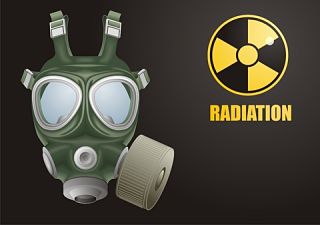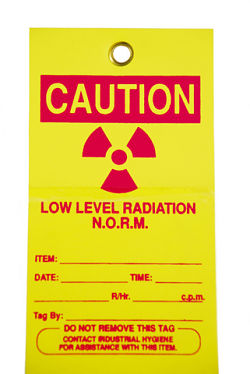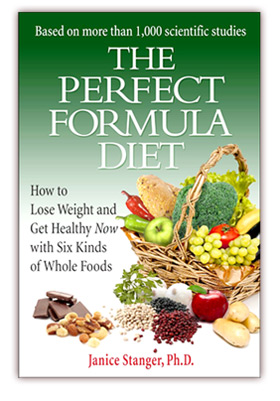
For high levels of radiation, stay away. Essential workers must be suited up for protection. You can't avoid low levels of radiation. Suit up with whole foods.
Diet Helps Shield You from Radiation and Cancer
The struggle to contain radioactive releases at Japan’s Fukushima Daiichi nuclear plant has focused the world’s attention on the hazards of radiation. However, even without such incidents, you are subject to harmful radiation every day.
Low-level background radiation bathes the earth. Cosmic rays are penetrating subatomic particles. According to NASA, about 100 of these particles bombard every square meter of the planet at sea level every second – and will pass through you if you are in their path. The number of powerful cosmic rays increases rapidly with altitude.
Additional radiation originates from radioactive materials at the earth’s surface. The amount varies by location. Finally, tiny amounts of radioactive forms of potassium, carbon, and other materials that make up your body get into your cells through food or other means.
The good news is that life evolved with this background radiation. Effective repair mechanisms offer protection from radiation within each cell. Every second your body is fixing the damage.
For the average American, radiation from manmade sources roughly doubles annual exposure from the natural background level. The biggest contributor to routine radiation is diagnostic medical imaging tests. The President’s Cancer Panel concluded that Americans receive 48% of their total radiation exposure from medical imaging and other medical sources, as opposed to only 15%
in the early 1980s. CT scans alone account for 24% of the total.
What is the risk from this doubling of natural radiation dosages? The answer is that no one knows The amount received is still orders of magnitude below that needed to trigger deadly acute radiation syndrome.
The answer is elusive because of the lag, which is often decades, between when a cancer begins and when it is diagnosed. By the time cancer is causing obvious symptoms, it’s often too late to pinpoint what factor or combination of factors caused it initially and kept it growing over the years. So scientists rely on statistical data rather than cause and effect studies.
Research indicates that even low levels of radiation increase the risk of cancer. Other hazards of radioactivity include genetic damage, which can be passed on even to the next generation, and decreased fertility.
Clearly, minimizing exposure to radiation is desirable. So is enhancing your body’s ability to repair damage caused by low-level radiation.
Luckily, whole plant foods offer a simple, effective, low-cost means to safeguard your health from both manmade and natural low-level radiation. Here are five ways they help, both by preventing radiation exposure and by speeding repair when powerful radioactive waves or particles penetrate your cells.
One. Roughly half of average radiation exposure is entirely avoidable. All you need to do is be healthy enough to not require diagnostic medical imaging studies. A whole foods, plant-based diet is an effective strategy to drastically reduce your risk of chronic illness that might lead a physician to recommend these tests.
For “preventive” imaging that uses x-rays, do careful research and weigh the pros and cons of each procedure. Be sure to ask your doctor if any test she recommends involves radiation. Understand how important it is to get it and what the alternatives are. This is especially true for children, who are more susceptible to radiation than adults are. A 2010 study of the insurance records of 355,088 children showed the average U.S. child had nearly eight diagnostic imaging procedures by age 18.
Two. The amount of radiation required for a medical test rises the more tissue the radiation must penetrate to form an image. Four to ten times as much radiation may be needed to complete a diagnostic test in an obese patient, as compared to a patient in a healthy weight range. A whole foods, plant-based diet is the path to permanent, hunger-free weight loss. So if you do need a diagnostic test, you will minimize the radiation damage by being at a lean weight.
Three. Dairy products are a major food source of radioactive elements in areas that have been contaminated by fallout from a nuclear incident. Other animal foods also concentrate the radioactivity in the plants used for feed. For example, after the Chernobyl disaster, the Swedish government carefully monitored radioactivity from plant and animal foods from contaminated areas. While most animal foods, including meat, dairy, and fish had higher levels of radioactive substances, most grains,
vegetables, potatoes, and fruit were below the safe limits.
Four. Radiation causes significant cellular damage by knocking into subatomic particles and forming free radicals. These are high energy, electrically charged particles that play havoc with the cell and can lead to cancer, among other illnesses.
Vitamins and phytochemicals (beneficial nutrients found only in plants) are powerful antioxidants, one of your body’s primary defenses against free radicals. Whole plant foods, including vegetables, fruits, beans, potatoes, whole grains, nuts, seeds, herbs, and spices, have an arsenal of nutrients to counter free radicals.
A study of 36,228 atomic bomb survivors of Hiroshima and Nagasaki demonstrates that plant power helps even in extreme circumstances. Survivors who ate fruits and vegetables daily had 13% less risk of dying from cancer over a twenty year period than those who consumed these foods less than once a week.
Five. Radiation also causes direct genetic damage at the cellular level. This can both cause cancer (if the damaged cell reproduces)

Atomic bomb survivors and airline pilots have been shown to be protected against radiation by colorful whole foods.
and harm the next generation when altered genes are passed on.
A 2009 study of airline pilots demonstrates the protective power of plant-based vitamins and phytochemicals. Recall that cosmic rays, an intense form of background radiation, increase significantly with altitude. Thus pilots are routinely subject to substantially higher radiation levels than the average person. Researchers chose a few vitamins and phytochemicals to study, and found that high amounts of these substances from food protected against genetic damage in a group of 83 pilots. While most nutrients were effective on their own, the best protection came from eating a wide assortment of fruits and vegetables with all the nutrients studied plus many more. Manufactured nutritional supplements were not effective – only food was.
Now you can add protection against the harmful effects of radiation to the long list of reasons to thrive on a whole foods, plant-based diet.
Intrigued? Now you can use our Whole Foods Blog Finder to target informative, fun postings on plant-based nutrition. Quick information at no cost!
Blog posting by Janice Stanger, Ph.D. Janice authored The Perfect Formula Diet, the smart person’s nutrition book built on sustainable food choices. Enjoy six kinds of whole foods for permanent, hunger-free weight loss and health.
Tags: cancer, Chernobyl, Fukushima Daiichi, getting healthy, Janice Stanger, medical imaging tests, phytochemicals, Plant-based nutrition, President's Cancer Panel, radiation, vegetables, weight loss, whole foods






